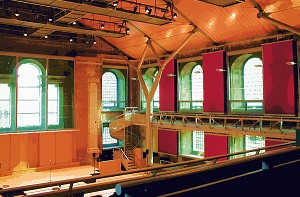|
A little-used name for the area surrounding the western half of Old Street. After its marshes were drained in the sixteenth
century, a hospital was built for plague victims, which stood until 1736. From medieval times until the slum clearance programme
of the 1870s its position on the edge of the City made St Luke’s a haven for all kinds of prohibited activities, from
astrology and wizardry to bear-baiting and prostitution. Thieves and pickpockets could make regular forays into the City and
then lose any pursuer in the maze of courts and alleyways around Whitecross Street, which nowadays has a more respectable
weekday market.
The reputation of St Luke’s as a ‘rookery’ – a zone of criminality – reached a peak in the first
half of the nineteenth century. ‘Flash houses’ – drinking dens and lodging houses where criminal plans were
laid and stolen goods fenced – were more numerous here than anywhere else in London. By 1900 southern St Luke’s
had become a district of workshops and warehouses, with new tenement blocks providing homes for law-abiding citizens. However,
many of the worst elements simply decamped to the other side of Old Street and this part remained disreputable until the 1930s.
St Luke’s primary school was founded in 1698. It is justifiably popular and oversubscribed.
|
 |
|
|
|
 |

|
| The refurbished interior of St Luke's church |
Completed in 1733, St Luke’s church is
attributed to Nicholas Hawksmoor and John James. Its tower is a fluted obelisk topped by a golden dragon that cockneys to
this day insist is really a plague flea. Subsidence problems led to the church’s closure in 1959, and the removal of
its roof. It lay derelict until 2003, when an education centre and rehearsal hall for the London Symphony Orchestra were built
in its shell. The grade I listed exterior has been faithfully restored and a new extension added.
|
 |
|
|
|

